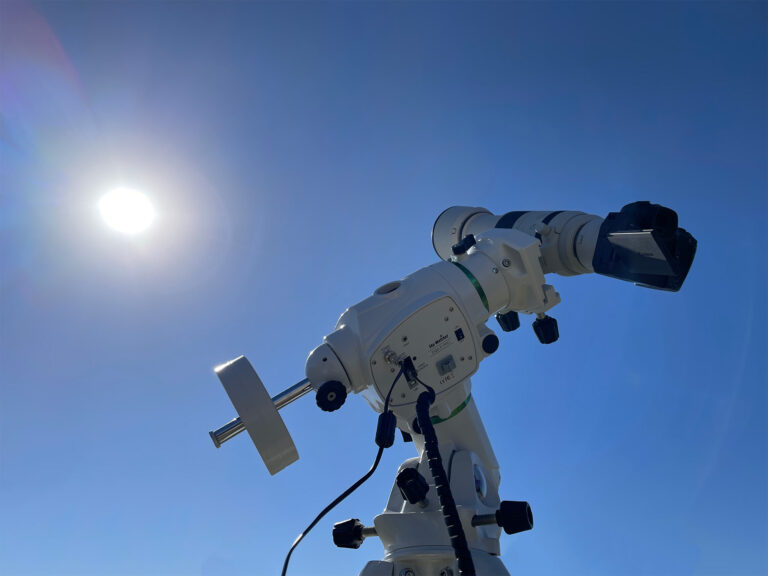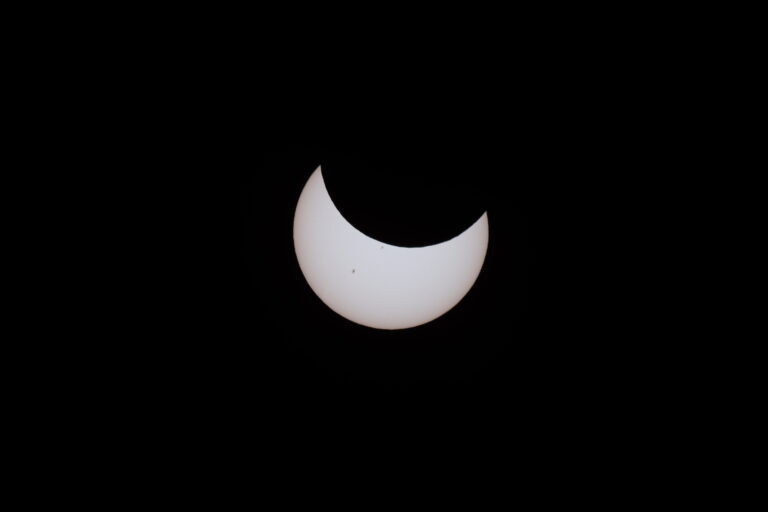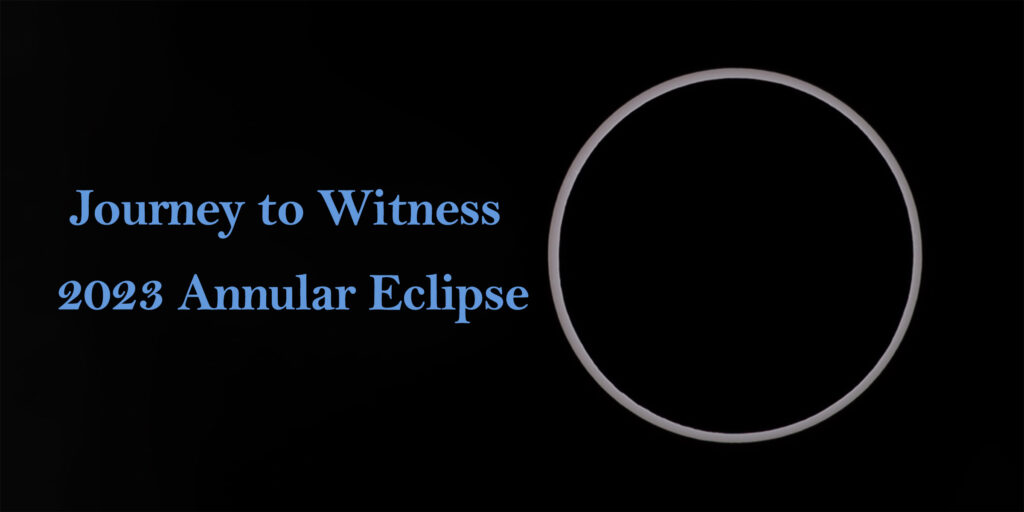On October 14, 2023, a celestial event of extraordinary beauty unfolded over the skies of Midland, Texas—the annular eclipse. This natural spectacle occurs when the moon passes between the sun and the Earth, creating a stunning ring of fire effect. Eager to witness this rare phenomenon, we embarked on a journey to Beal Park in Midland, armed with our trusty equipment: a SkyWatcher equatorial tripod, a Canon Ra camera, an RF 100-500mm lens, and a special solar filter. In this article, we’ll recount our adventure, from setup to capture, as we captured the mesmerizing progress of the annular eclipse and the perfect ring it formed.
1. Astronomy Enthusiasts on the Move
For astronomy enthusiasts, an annular eclipse is a bucket-list event. The opportunity to witness the moon partially obscure the sun, leaving behind a blazing ring, is a sight to behold. Our journey began weeks in advance as we meticulously planned for this extraordinary day. Midland, Texas, known for its clear skies and minimal light pollution, was the perfect destination for our celestial adventure.
2. Arriving at the location: Beal Park
Beal Park, nestled within the heart of Midland, was our chosen location to set up our equipment and witness the annular eclipse. The park’s wide-open spaces and scenic surroundings promised an ideal vantage point for celestial observations. Arriving early in the morning, we were met with a sense of excitement and anticipation shared by fellow eclipse chasers who had also gathered at this location.

3. Setting Up the Equipment
Preparation is key when capturing celestial events like an annular eclipse. With our eyes firmly on the skies, we set up our equipment methodically.
SkyWatcher Equatorial Tripod: The SkyWatcher equatorial tripod was our sturdy foundation. Equipped with a motorized tracking system, it allowed us to keep our camera perfectly aligned with the sun as it moved across the sky.
Canon Ra Camera: For this special occasion, we chose the Canon Ra, a dedicated astrophotography camera renowned for its low-light capabilities and exceptional sensor. This camera would be our lens to the heavens.
RF 100-500mm Lens: The RF 100-500mm lens offered us the flexibility to capture both wide-angle shots of the eclipse’s progress and close-up details of the ring of fire. Its optical image stabilization ensured crisp, clear images.
Special Solar Filter: Safety is paramount when observing the sun, and we relied on a specially designed solar filter to protect our eyes and camera sensor from harmful solar radiation. This filter allowed us to photograph the sun without risking damage.
4. The Progress of the Annular Eclipse
As the morning sun rose higher in the sky, the anticipation among the eclipse watchers intensified. At the predicted time, the moon began its slow journey across the sun’s face, gradually covering a significant portion of its disk.
First Contact: The initial contact was a thrilling moment as a small, dark notch appeared at the edge of the sun. This marked the beginning of the eclipse.
Partial Eclipse: Over the course of several minutes, the moon continued to encroach upon the sun, creating a crescent shape that grew more pronounced with each passing moment. Our camera, mounted on the equatorial tripod, tracked the sun’s movement, ensuring that our shots remained centered and precise.
Ring of Fire: As the moon’s silhouette aligned perfectly with the sun’s disk, a breathtaking phenomenon unfolded—the ring of fire. The moon’s smaller apparent size compared to the sun created a visible halo of fiery light around its edges. The resulting image was nothing short of awe-inspiring.
Maximum Eclipse: At the peak of the eclipse, we captured the sun reduced to a radiant ring, casting a surreal, ethereal glow across Beal Park. The sky around us took on a unique quality, with hues of orange and pink painting the landscape.
Progressive Phases: The annular eclipse continued its progression, with the moon slowly moving away from the sun. As the ring of fire began to diminish, we continued to document every phase, creating a time-lapse of this celestial dance.

5. Perfect Timing and Precision
The success of capturing a perfect ring during an annular eclipse hinges on precise timing, equipment preparation, and, of course, a little bit of luck. As the eclipse neared its climax, we marveled at the results of our careful planning and preparation.
Timing: Timing is critical when photographing an eclipse. We relied on precise calculations and timing tools to ensure that we didn’t miss any of the crucial phases. Being in the right place at the right time was paramount.
Equipment Alignment: Our SkyWatcher equatorial tripod played a pivotal role in keeping our camera consistently aligned with the sun. This motorized mount tracked the sun’s movement, allowing us to maintain a perfect focus on the eclipse throughout its progression.
Exposure Settings: Proper exposure settings were essential to capture the eclipse’s details while preserving the ring of fire. We adjusted our camera settings as the eclipse evolved, ensuring that each shot was perfectly exposed.
Solar Filter: The use of a specialized solar filter was non-negotiable. It protected both our eyes and camera sensor from the sun’s intense rays, allowing us to photograph the eclipse safely.
Patience and Adaptability: Observing and photographing an eclipse demands patience and adaptability. We were prepared for changing lighting conditions and fluctuations in weather, adjusting our equipment and settings as necessary.

6. Awe-Inspiring Results
As the annular eclipse reached its conclusion and the sun emerged once more, we reviewed our images with a sense of satisfaction and wonder. The photographs we had captured were not just records of a celestial event but visual testaments to the magnificence of the universe.
8. The Perfect Ring: Our Camera’s Perspective
The highlight of our adventure was undoubtedly the capture of the perfect ring—a mesmerizing circle of fire encircling the moon’s silhouette. This phenomenon is a testament to the precise alignment of the moon and the sun during an annular eclipse, resulting in a visual spectacle that leaves observers in awe.
Our Canon Ra camera, equipped with the RF 100-500mm lens and the special solar filter, allowed us to capture this moment with remarkable clarity and detail. Each frame showcased the ring’s fiery brilliance, with intricate solar prominences visible along its edge.
7. Beyond the Ring: Capturing Eclipse Phases
While the ring of fire stole the show, our photographic journey also involved capturing the various phases of the annular eclipse. From the initial contact, through the partial eclipse, to the moment of maximum eclipse, we documented the entire progression.
Crescent Sun: During the partial eclipse phase, the sun took on the appearance of a crescent, reminiscent of a waning moon. Our camera revealed intricate sunspots and solar details that added depth and complexity to our photographs.
Changing Colors: The eclipse’s progression also brought about subtle changes in the colors of the landscape and the sky. The shifting hues—ranging from deep orange to soft pink—added an artistic dimension to our images.
Time-Lapse Sequences: To capture the eclipse’s dynamic nature, we created time-lapse sequences that showcased the moon’s movement as it traversed the sun’s disk. These sequences provided a unique perspective on the event’s gradual unfolding.
9. The Emotional Impact
Photographing an annular eclipse is a breathtaking experience that transcends the technical aspects of camera settings and equipment. It is a deeply emotional journey that connects observers with the cosmos in a profound way.
Awe and Wonder: Witnessing the annular eclipse evokes a sense of awe and wonder that is difficult to put into words. The sight of the ring of fire, framed by the vast expanse of the Texas sky, is a humbling reminder of the grandeur of the universe.
Sense of Unity: Gathered at Beal Park with fellow eclipse enthusiasts, we felt a sense of unity with people from diverse backgrounds and cultures, all brought together by a shared love for astronomy and the cosmos.
Appreciation for Nature: Observing an eclipse reminds us of the delicate balance and precision of celestial movements. It fosters a deep appreciation for the natural world and our place within it.
Inspiration: Our photographic journey during the annular eclipse inspired us to continue exploring the night sky and capturing the beauty of the cosmos through our lenses. It ignited a passion for astrophotography that will stay with us for years to come.
The annular eclipse of October 14, 2023, provided us with a once-in-a-lifetime opportunity to witness and photograph a celestial event of unparalleled beauty. Our journey to Beal Park in Midland, Texas, equipped with a SkyWatcher equatorial tripod, a Canon Ra camera, an RF 100-500mm lens, and a special solar filter, resulted in stunning images that showcased the eclipse’s progression and the breathtaking ring of fire.
Beyond the technical aspects of photography, our experience was deeply emotional, evoking feelings of awe, wonder, unity, and inspiration. It reminded us of the profound connection between humanity and the cosmos and underscored the importance of preserving and cherishing the natural world.
As we packed up our equipment and watched the sun return to its full splendor, we couldn’t help but feel grateful for the privilege of witnessing such a rare and awe-inspiring event. Our photographs serve as lasting mementos of this incredible journey, a testament to the beauty and wonder of the universe that surrounds us.
For more information, visit Bel Oak Marketing.





